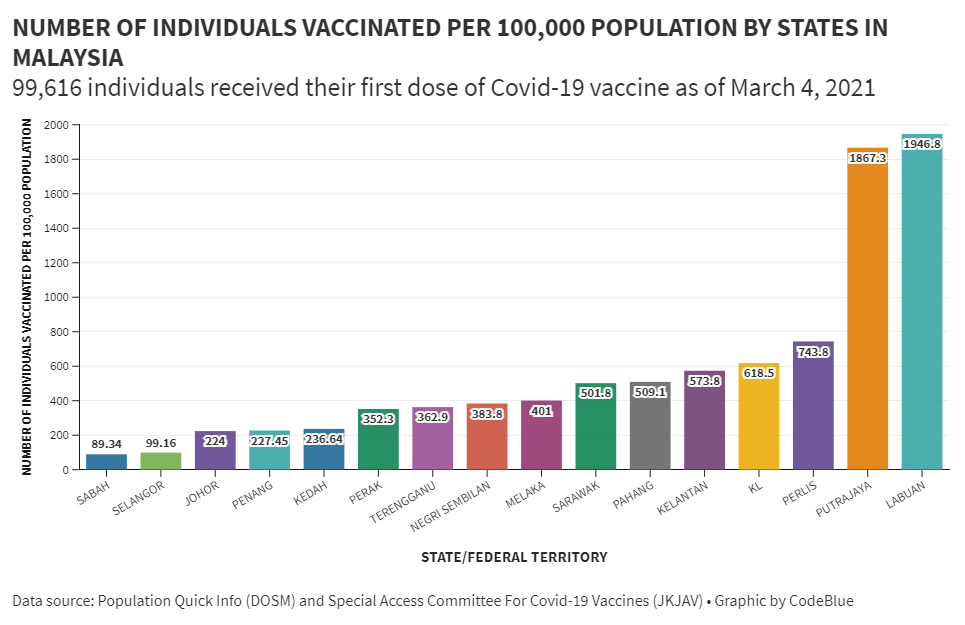KUALA LUMPUR, March 5 — Selangor’s Covid-19 vaccination rate is the second lowest in Malaysia, just slightly ahead of Sabah, despite being the country’s most developed state.
Based on the Covid-19 Immunisation Task Force’s (CITF) absolute count of first doses administered as of March 4, CodeBlue calculated that Sabah had the slowest Covid-19 inoculation rate in Malaysia at about 89 doses administered per 100,000 residents, slightly lower than Selangor’s 99 per 100,000 population.
Labuan had the highest vaccination rate in Malaysia at about 1,947 people who received their first dose per 100,000 population. This means Selangor’s Covid-19 vaccination rate is a whopping 20 times slower than Labuan, an island neighbouring Sabah, the poorest state in the country.
A total of 99,616 people nationwide received their first dose of the Covid-19 vaccine as of March 4, translating to about 12,452 shots to the arm daily among frontline workers since the launch of the national inoculation drive on February 24. CITF targets to inoculate 500,000 frontline workers, including health care providers, by the end of the month.
“I think the issue is still the same like the one that contributed to the gap in contact tracing– ‘hogging’ all works, even one that can be safely delegated, within the walls of JKN (state health department) and MOH (Ministry of Health),” Selangor Task Force Covid-19 (STFC) member (digital epidemiology) Dr Helmi Zakariah told CodeBlue.
“The insistence that all scheduling, appointment booking, and administration be centralised by JKN and the district health offices and public health clinics (Klinik Kesihatan) is disconcerting.
“But, MOH human resources are limited. The people that are supposedly executing this vaccination programme are the same people that still need to handle contact tracing, community screening, Covid-19 Assessment Centres (CAC) etc. Selangor is still seeing a high number of cases, although it’s trending down. I feel nothing but sympathy to my fellow medical colleagues juggling so many roles.”
Selangor reported about 706 daily Covid-19 cases on a five-day moving average on February 27.
Dr Helmi pointed out there’s a reason why MOH gets the private practice to help with its National Immunisation Programme (NIP) to ensure widespread coverage of child vaccination, citing manpower, geographical coverage, and speed.
“It’s not a secret that health care worker distribution in Malaysia suffers from inequality,” he said, citing Harvard’s Malaysia Health Systems Research 2016 and WHO’s Malaysia Health System Review back in 2013.
“At the risk of oversimplification, the primary health system inherited an 80/20 phenomenon in urban areas especially, where 80 per cent of primary care providers work in private settings, compared to 20 per cent in the public sector.”
Dr Helmi Zakariah, Member of the Selangor Task Force Covid-19

The public health practitioner also highlighted concerns by some parties, which he did not name, on the inefficiencies in the vaccine registration and scheduling process under the MySejahtera app.
Dr Helmi said during the current first phase of the national Covid-19 vaccination programme for frontline workers, including health care providers, reports emerged that heads of departments in hospitals are required to list the names and particulars of health care workers for jabs. This is called “staff linelisting”.
Each health facility then sends its health care worker “linelisting” to their respective state health department, which is then tasked to key in the particulars into MySejahtera to determine one’s vaccination appointment time.
“This takes days, if not weeks,” Dr Helmi told CodeBlue.
Instead of allowing individual health facilities with ultra-low temperature freezers to store their own Covid-19 vaccine stocks and to set vaccination appointments for their staff, the state health department has to unilaterally decide the booking slots, which can be cumbersome, said Dr Helmi.
The vaccination slots are made through the MySejahtera system so that a booking slot notification can appear in the app. While this is useful to some degree, said Dr Helmi, it pales in comparison to the manual efforts required to “digitise” those booking slots.
“‘Incomplete automation’ is a longstanding problem in the health tech world, and not new to this pandemic, especially when we don’t consider a human-centric design,” Dr Helmi said.
“It looks canggih on your phone or computer, but it doesn’t cut time and process; rather, it lengthens it. The losers are the health care workers because of delayed vaccines rollout. These process gaps should be addressed if we are to ensure vaccination coverage as wide, and as efficient as possible.”
CITF did not respond to CodeBlue’s requests for comment at the time of writing.








